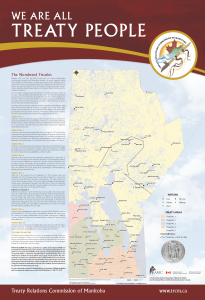Acknowledging Traditional Territories
Activity
Watch these two short videos and try to pick out the main idea from each one.
Land Acknowledgment–Baroness Von Sketch Show (2 min, 14 sec)1
What is a Territorial Acknowledgement?
A Territorial (Land) Acknowledgement is a respectful way to honour Indigenous people and to recognize that they have lived on these lands for thousands of years. We usually mention the treaty territory on which we stand when giving an acknowledgement. Treaties are mutual agreements between nations. Canada has signed many treaties with Indigenous Peoples, from coast to coast. The spirit and intent of those treaties were to share and care for the land together, forever.
Individuals or organizations will often acknowledge the First Peoples on whose traditional territories they live and work. This acknowledgement takes place at ceremonial events (awards/graduations), feasts, gatherings, orientations, workshops, celebrations, and announcements. It is not necessary to do a land acknowledgment at the opening of, say, each class session. Also, giving a land acknowledgment is highly personal to the one giving it. Calling upon someone to “do” a land acknowledgment without making those arrangements in advance and in private can place people in an uncomfortable position. Some Indigenous Peoples do not believe that they should deliver an acknowledgment, as they are the Original Peoples. Some, however, will deliver a welcome to the territory. It is also appropriate to acknowledge when one is a guest in another territory. In that way, there is a spirit of hospitality, both in hosting and in being a good guest. These acknowledgments speak to the larger concern of caring for one another and the environment in a way that leaves the Earth intact for future generations.
Land acknowledgements vary in length and scope, with some being very personal while others formal acts or statements from governments and organizations. Whenever you hear a land acknowledgement, it’s important to think about:
- The history of this territory and its people
- The impacts of colonialism to the land and its people
- Your relationship to this territory and its people (past, present, and future)
Unceded means that First Nations people never ceded or legally signed away their lands to the Crown or to Canada. A traditional territory is the geographic area identified by an Indigenous Nation as the land they and/or their ancestors traditionally occupied and used. In Manitoba, the Dakota First Nations lands are also unceded territories.
If you wish to add a traditional territories acknowledgement to your own work, be sure to check with a knowledgeable source in your organization to be sure it is worded correctly and that the nations are represented accurately. If you are delivering an oral acknowledgement, do it slowly and enunciate clearly. Check on how to pronounce names. Acknowledging territory is meaningful as long as it is undertaken in a respectful way. If an acknowledgement is conducted in a way to ‘check off a to-do task,’ then it is considered tokenistic and inappropriate. When you give a land acknowledgment, it is important to think about the context of the event and why you are doing it.
It is not necessary to follow a scripted acknowledgment, but some use a script until they build their own knowledge and reflective practices. Also remember, this is a learning journey for all of us in this relationship–do not be offended if you are corrected–we are all in this together!
Assiniboine College Territorial Acknowledgment Example
Assiniboine College campuses are located on the traditional territories of Treaty No. 1 and Treaty No. 2, and the shared traditional lands of Cree, Oji-Cree, Dakota, Dene and Anishinaabek/Ojibwe peoples, and the homeland of the Métis Nation. We also recognize other Treaty territories where our community-based training takes place. We welcome students who seek knowledge here.
Our Commitment | Assiniboine College3
Brandon University Territorial Acknowledgment Example
Brandon University campuses are located on both Treaty 1 and Treaty 2 territories. Our main campus is located in Brandon, Manitoba, on Treaty 2 territory. This is traditional shared land between the Dakota, Ojibway and Métis peoples. We at Brandon University acknowledge and respect the history, land and the people of this area.
It is important to recognize that practices around territorial land acknowledgments are complex and evolving. Indigenous peoples have a variety of opinions on territorial land acknowledgments. As your engagement with Indigenous peoples grows, you may want to expand your thinking around acknowledging Indigenous origins and realities. For a more thorough discussion of land acknowledgments, check out this article by Robinson et al. (2019).
Rethinking the Practice and Performance of Indigenous Land Acknowledgement5
Here is a map of the First Nation traditional territories in Manitoba6:

Media Attributions
‘Manitoba Numbered Treaties Map’ (Treaty Relations Commission of Manitoba) is licensed under an All Rights Reserved License.
Notes
- Land Acknowledgement: Baroness Von Sketch Show (https://www.youtube.com/watch?v=xlG17C19nYo)
- Land Acknowledgement: Stephen Paquette (https://www.youtube.com/watch?v=xlG17C19nYo)
- ACC Commitment (https://assiniboine.net/study-here/why-assiniboine/indigenous-students/our-commitment)
- BU Indigenous Peoples’ Centre (https://www.brandonu.ca/ipc/)
- Rethinking the Practice and Performance of Indigenous Land Acknowledgement (https://med-fom-osot-inclusive-campus.sites.olt.ubc.ca/files/2021/04/Rethinking-the-Practice-and-Performance-of-Indigenous-Land-Acknowledgement.pdf)
- Traditional Territories Map (http://www.trcm.ca/treaties/treaties-in-manitoba/view-pdf-interactive-map-of-numbered-treaties-trcm-july-20-entry/)

